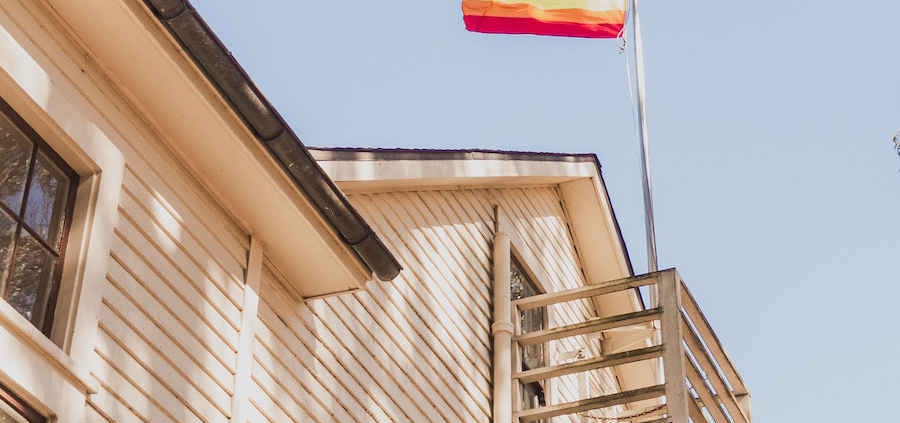Lessons from My Two Years as a Gay Catholic by Michael E. DeSanctis
For a time in the mid-1980s, while finishing some degree work at a midwestern university, I took a room in a house owned by a gay gentleman whose preference was to rent the three or four units beneath his roof to other gay men. An exceptionally generous soul, this landlord was known throughout the academic community for the extravagance of his dinner parties. To me, in fact, the rare straight person to have found a place in his busy household, he seemed like Fezziwig from Dickens’s A Christmas Carol, quick with a drink or dance-step to delight guests he often drew from the subterranean network of gays and lesbians in town. People laughed and sang and argued uproariously at his table, relieved, I assumed, just to be themselves for a while. Dining in that house was both theater and therapy where the only requirement was to dispose of one’s masks.
None of this sat well with the group of fraternity brothers living next door, unfortunately, whose drunken bodies I’d sidestep on Sunday mornings while walking to Mass. They’d somehow discovered that the narrow driveway separating our properties represented more than a boundary between two modes of civility—and they weren’t afraid of announcing their feelings to anyone within earshot. “Faggots!” somebody shouted from their front porch as I walked by one weekend with a Catholic housemate I’ll call “Nathan” who’d joined me for church. It was nothing he hadn’t heard before as a gay person struggling to function in a world where heterosexuality was the norm and a church where it was the law. “At least you can fall in love, get married and be intimate with someone,” he’d lament during the theological free-for-alls we’d share late into the night, the kind to which wine ends up inducing less truth than trauma. “I love being Catholic,” he insisted time and again, “but what do I do with a body the Catechism calls ‘intrinsically disordered’?”
The two of us grew weary of trying to squeeze the lofty Natural Lawfulness and universal application of the church’s rules on sex into the narrow particularity of Nathan’s life and lifestyle, almost always to the throb of party music from next door. His pain and confusion were palpable, and you got the sense as he spoke that he’d arrived at the inescapable predicament facing Catholics who today identify with a thoroughly aboveground LGBTQ community: Should he choose the sanity that could come from accepting his interior biochemistry for what it is—unchosen and unshakable—or a version of sanctity free of sexual fulfillment and the benefits of serious companionship?
Every Catholic knows that both single and married heterosexuals, too, are obliged to be chaste, and that the rightness or wrongness of any sexual act hinges on whether it supports heaven’s plan for the transmission of life and love within the uniquely nurturing bounds of marriage. But biology was working against Nathan, at least as concerned the possibility of entering into a sacramental union with anyone, and he was happy to leave any complicated moralizing on the subject of sex to a God entirely free of earthly passions. It’s become popular in Catholic circles and elsewhere, ever since Pope Francis’s famous “Who am I to judge?” remark to a plane full of reporters a few years ago, to do likewise or to lapse into an “anything goes” misreading of the hand the pope has extended to the LGBTQ community worldwide from the outset of his pontificate.
Looking back from the distance of nearly 35 years, I realize that my own advice to Nathan was as presumptuous as it was simplistic. “Maybe God wants you single and celibate for the rest of your life, like a monk,” I’d tell him, secretly shrinking from the implication of my words and wondering how I would feel in his shoes. The irony in this, as it turned out, is that I had walked a little in his shoes, at least those times when the boys of Dumb-n-Dumber Epsilon lobbed insults my way for being a resident of the “homo house” spoiling their neighborhood.
Nowadays, my late-night conversations about human sexuality are with my physician-wife, whose familiarity with the latest research on the topic leaves us wondering whether the “nature” at the heart of the church’s natural law approach to sex doesn’t require at least some prayerful reconsideration. It’s not just that the handful of definitions to which even the most liberally-minded people once submitted sexual behaviors turns out to be so inadequate; it’s that the very range of sexual personae people of all sorts today admit to embodying seems so dizzyingly wide.
What I know for sure is that the two years in grad school when I learned to empathize with the trials of gay men and other sexual minorities, dutifully upholding the church’s view on things while deflecting the slurs intended for my gay housemates, makes me appreciate why the official policy for ministering to the needs of LGBTQ students at the Catholic university where I’d end up as a professor myself was simply to “walk beside them.” In the end, that’s all any of us wants, to be accompanied in this life by friends or housemates or entire churches whose concerns regarding “orientation” lie primarily with the heart, and whose tables are spread before us free of judgment, our masked and made-up selves God’s business alone to judge.
Michael E. DeSanctis, Ph.D., is retired professor of fine arts and theology at Gannon University in Erie, Pennsylvania. He writes widely on Catholic church architecture and serves as a liturgical designer and consultant.





Mahalo/Thank You for your well thought out words.